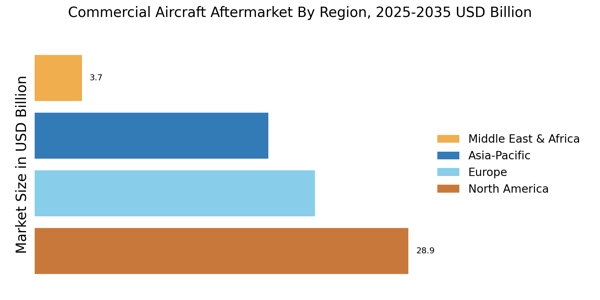Growing Fleet Size and Aging Aircraft
The expansion of airline fleets and the increasing age of existing aircraft are pivotal drivers in the Commercial Aircraft Aftermarket Industry. As airlines continue to expand their operations, the demand for aftermarket services is expected to rise correspondingly. The global fleet of commercial aircraft is projected to grow significantly, with estimates suggesting an increase of over 40% by 2030. Concurrently, many aircraft in operation are reaching the end of their operational life, necessitating more frequent maintenance and parts replacement. This dual trend of fleet growth and aging aircraft creates a robust market for aftermarket services, compelling MRO providers to innovate and expand their offerings.
Increased Demand for Digital Services
The shift towards digitalization is a significant driver in the Commercial Aircraft Aftermarket Industry. Airlines are increasingly seeking digital solutions that enhance operational efficiency and customer experience. This includes the adoption of digital platforms for inventory management, predictive maintenance, and customer relationship management. The market for digital MRO solutions is projected to grow substantially, with estimates suggesting a compound annual growth rate of over 15% in the coming years. As airlines strive to leverage data analytics and digital tools, the demand for innovative digital services within the Commercial Aircraft Aftermarket Industry is likely to expand.
Regulatory Compliance and Safety Standards
The Commercial Aircraft Aftermarket Industry is heavily influenced by stringent regulatory compliance and safety standards imposed by aviation authorities. These regulations necessitate regular inspections, maintenance, and upgrades to ensure aircraft safety and reliability. As regulations evolve, airlines and MRO providers must adapt their practices to meet these requirements, which often leads to increased spending on aftermarket services. The market for aircraft maintenance services is projected to reach approximately 100 billion dollars by 2026, driven in part by the need for compliance with these regulations. This trend underscores the critical role of regulatory frameworks in shaping the Commercial Aircraft Aftermarket Industry.
Sustainability and Environmental Regulations
Sustainability initiatives are becoming increasingly important within Commercial Aircraft Aftermarket Market. Airlines are under pressure to reduce their carbon footprint and comply with environmental regulations, which is driving demand for more sustainable aftermarket solutions. This includes the use of eco-friendly materials in repairs and the implementation of recycling programs for aircraft parts. The market for sustainable aviation solutions is expected to grow, with estimates indicating a potential increase in investment in green technologies by 20 billion dollars over the next decade. As environmental concerns continue to shape industry practices, the Commercial Aircraft Aftermarket Industry must adapt to meet these sustainability goals.
Technological Innovations in Aircraft Maintenance
The Commercial Aircraft Aftermarket Market is experiencing a surge in technological innovations that enhance maintenance, repair, and overhaul (MRO) processes. Advanced technologies such as predictive analytics, artificial intelligence, and the Internet of Things (IoT) are being integrated into MRO operations. These innovations facilitate real-time monitoring of aircraft components, allowing for proactive maintenance and reducing downtime. According to industry estimates, the adoption of these technologies could lead to a reduction in maintenance costs by up to 30%. As airlines seek to optimize operational efficiency, the demand for technologically advanced solutions in the Commercial Aircraft Aftermarket Industry is likely to grow.


















Leave a Comment